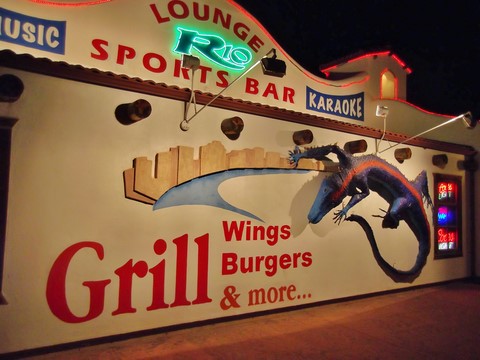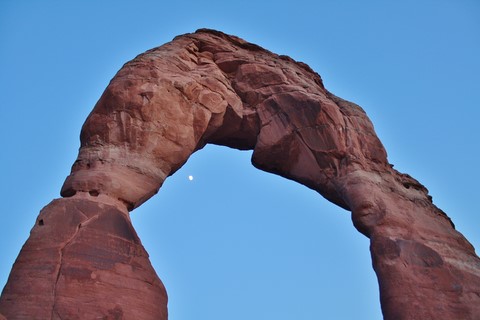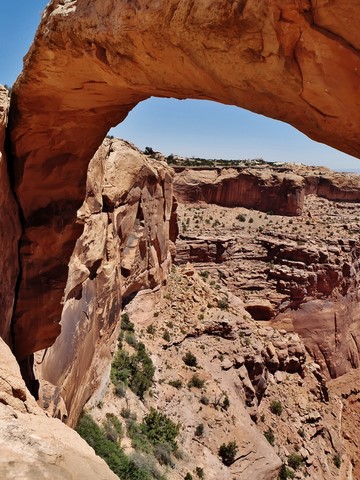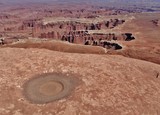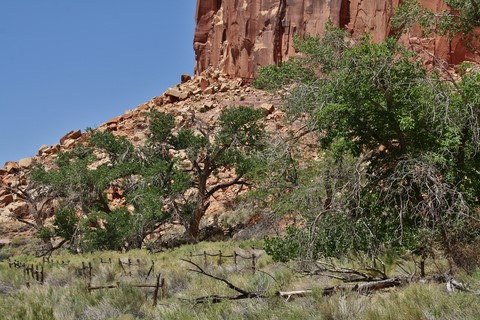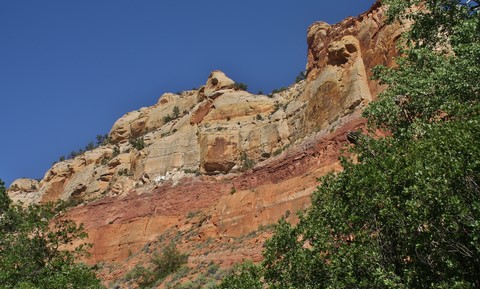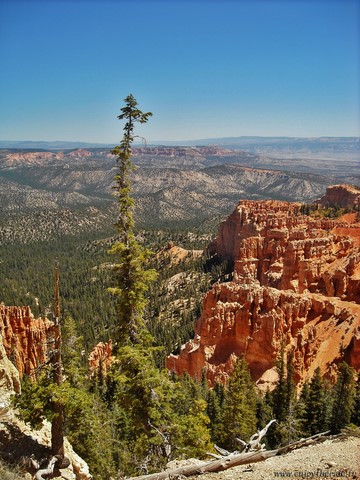Utah
You can click on pictures to enlarge them
Moab
It is a typical small town, young and dynamic. The city center is very nice. We chose to stay there two days to visit Arches National Park and Canyonlands, before going to Bryce Canyon. To join it from Monument Valley, we stopped at Mexican Hat, amazing rock with the shape of a Mexican hat, as the name suggests. It also gave its name to a whole village in the middle of nowhere. The road to Moab was full of surprises: we saw deer, wild horses, and a llama farm. Sometimes, we saw dust swirling up, a phenomenon that we had never seen before. The Moab Valley Inn motel where we spent two nights is high-quality. Its swimming pool and Jacuzzi are very pleasant after the furnace of national parks.
Beyond the proximity to those sites which make it a conveniently located stopping-off point, Moab has much to offer for a short stay: its streets are very welcoming, its restaurants and cafés are nice and its souvenir shops are amazing and funny. Sports shops are not forgotten: there is indeed a long-standing tradition in Moab for mountain biking and rafting. Besides, you feel its inhabitants are very close to nature.
The second night, we decided to take a walk in town to immerse ourselves in the atmosphere. As we were moving away from Main Street to a more secluded spot, we were surprised to see an old rusted cart on rails that was formerly used to transport gold. That brought us to the 19th century, when the gold rush was at its height.
Finally, you can eat very well there. In typical restaurants, of course, but also at Denny's, a restaurants chain we did not know at all, and which pleasantly surprised us. The quality-price ratio is excellent. In addition, it is open late, which was an advantage when we returned late from the Arches National Park, that we wanted to visit at sunset. All restaurants were closed, but one of the waitresses directed us to Denny's, in a very nice gesture of goodwill, which is part of typically American kindness and availability. On the second evening, we ate at the restaurant Zak Pizza on Main Street. Dishes are high-quality, notably wood-fired pizzas, red meat and desserts. The decoration is really nice.
At the supermarket, the choice at the food section is remarkable. You can compose your own salad, as well fruits as vegetables: numerous stalls to the fresh food department are at your disposal and you fill your carton as you like.
For all those reasons, we greatly recommend a stop at Moab to those who wish to visit the national parks of Utah.
The second night, we decided to take a walk in town to immerse ourselves in the atmosphere. As we were moving away from Main Street to a more secluded spot, we were surprised to see an old rusted cart on rails that was formerly used to transport gold. That brought us to the 19th century, when the gold rush was at its height.
Finally, you can eat very well there. In typical restaurants, of course, but also at Denny's, a restaurants chain we did not know at all, and which pleasantly surprised us. The quality-price ratio is excellent. In addition, it is open late, which was an advantage when we returned late from the Arches National Park, that we wanted to visit at sunset. All restaurants were closed, but one of the waitresses directed us to Denny's, in a very nice gesture of goodwill, which is part of typically American kindness and availability. On the second evening, we ate at the restaurant Zak Pizza on Main Street. Dishes are high-quality, notably wood-fired pizzas, red meat and desserts. The decoration is really nice.
At the supermarket, the choice at the food section is remarkable. You can compose your own salad, as well fruits as vegetables: numerous stalls to the fresh food department are at your disposal and you fill your carton as you like.
For all those reasons, we greatly recommend a stop at Moab to those who wish to visit the national parks of Utah.
Arches National Park
It is a small surprising park which groups together the largest concentration of natural arches in the world, molded in magnificent red sandstone, of all sizes. Some exceed 80 meters range. A tarred road about 23 miles long runs across the Park from North to South. Most of those arches are easily accessible by car or after a 15 minute walk. The most famous are Landscape Arch, a 90 meters long rock strip over a sandstone amphitheater, Double Arch, and Delicate Arch (photo), which became the idealized image of Utah that appears on license plates of the state.
There are also other amazing rocks: suspended rocks (like Balanced Rock), fairies chimneys, and vertiginous red cliffs.
So, we visited the park late in the day so that we can admire it at sunset. Colors were fabulous. We ended up at Delicate Arch, and the two kilometers trekking to access there was rather physical on the end with the climb. But the effort was really worth.
There are also other amazing rocks: suspended rocks (like Balanced Rock), fairies chimneys, and vertiginous red cliffs.
So, we visited the park late in the day so that we can admire it at sunset. Colors were fabulous. We ended up at Delicate Arch, and the two kilometers trekking to access there was rather physical on the end with the climb. But the effort was really worth.
Canyonlands
That park offers a summary of the most grandiose landscapes in the West. It is very extensive and it has many remarkable places: Island in the Sky, Grand View Point Overlook (the most impressive), Mesa Arch (photo), Needles Overlook, and The Maze which is one of the most remote places of the U.S.A.
Its rocks molded by erosion have infinitely varied outlines and colors. Imposing, they look like arches or needles, forming geological extravagances that make that region a unique place. Vast expanses of hills and mesas fill each panorama.
In places, the vegetation is surprisingly deep green if you take into account the aridity of the place and the oppressive heat, made worse by a warm wind. Several trails are proposed, including one that leads to a vast crater which origin is unknown that stirs visitors curiosity. The overlooking view makes it even more impressive.
Its rocks molded by erosion have infinitely varied outlines and colors. Imposing, they look like arches or needles, forming geological extravagances that make that region a unique place. Vast expanses of hills and mesas fill each panorama.
In places, the vegetation is surprisingly deep green if you take into account the aridity of the place and the oppressive heat, made worse by a warm wind. Several trails are proposed, including one that leads to a vast crater which origin is unknown that stirs visitors curiosity. The overlooking view makes it even more impressive.
Dead Horse State Park
We made a stop there on our way back from Canyonlands. That is not a national park, so the pass is not valid for access and you have to pay $10 per vehicle. Fortunately, the panoramic view of the Colorado River and its meanders is fantastic. A hiking route goes round the ark, allowing access to all viewpoints.
Capitol Reef National Park
That wild park is the less busy of the national parks of Utah. Yet, it would be a pity not to stop there. It stretches in high and semi-arid areas. It is mainly made up of natural arches and canyons, but there are many variations in the different types of landscapes. There too, the contrast of colors between rock and vegetation is remarkable. It abounds in many geological, animal, plant and cultural riches.
At the entrance lies a magnificent orchard for visitors who can eat fruits. The atmosphere is bucolic. In the Oasis of Fruita, you can see deer on green meadows. Cathedral Valley, with its huge monoliths, is one of the most beautiful parts of the park, but one of the hardest to get to (you can only get there with a 4-wheel drive vehicle). It has a staggering setting. The road to the park ends with a large deep canyon which offers a surprising landscape.
At the entrance lies a magnificent orchard for visitors who can eat fruits. The atmosphere is bucolic. In the Oasis of Fruita, you can see deer on green meadows. Cathedral Valley, with its huge monoliths, is one of the most beautiful parts of the park, but one of the hardest to get to (you can only get there with a 4-wheel drive vehicle). It has a staggering setting. The road to the park ends with a large deep canyon which offers a surprising landscape.
National Scenic Byway 12
After making a stop in Torrey, very pleasant small village, we drove along that picturesque road that connects Capitol Reef and Bryce Canyon. It rises from 1200 to 3300 meters above sea level and runs along canyons, skirts round stunning cliffs, striated rock faces, crosses birch and pine forests. It is the major tourist attraction in Utah on its own. Those rock massifs bordering on red and yellow are covered with thorny forests and crossed by rivers.
In the Grand Staircase-Escalante National Monument, you can admire a petrified forest, reddening canyons and the Kaiparowits Plateau. When you get to Cannonville, do not hesitate to make a detour to the Kodachrome Basin State Park, with multicolored rocky landscapes. Red Canyon, nicknamed «Little Bryce», is located west of Bryce Canyon and offers the same kind of landscape.
In the Grand Staircase-Escalante National Monument, you can admire a petrified forest, reddening canyons and the Kaiparowits Plateau. When you get to Cannonville, do not hesitate to make a detour to the Kodachrome Basin State Park, with multicolored rocky landscapes. Red Canyon, nicknamed «Little Bryce», is located west of Bryce Canyon and offers the same kind of landscape.
Bryce Canyon National Park
Spectacular site, it is more a gigantic amphitheater than a genuine canyon. It is horseshoe-shaped and made up of incredible colored peaks, turrets, «hoodoos» (big orange earth chimneys), temples and natural minarets. The vegetation is mainly composed of ponderosa pines and cedar trees. Petroglyphs testify that it was inhabited millions years ago. It is certainly less grandiose than the Grand Canyon, but more typical from the geological point of view: its rocky spirals are very characteristic, and its clay reddened by iron oxide gives it extraordinary colors, including red, pink and cream. That wonder of nature is absolutely essential.
A scenic drive follows the jagged plateau and gives access to the 14 viewpoints of the Park. You can even see the Grand Canyon and Lake Powell. Sunset Point, Sunrise Point, Rainbow Point and Bryce Point are breathtaking. Many hikes are proposed, as well as rides on horseback and a flying-over by plane.
We first visited Bryce Canyon at sunset, before going back there the next morning. Its rocks, with strange outlines, were sparkling and tinged with warm colors. On the other hand, given the high altitude of the site, be aware that mornings and evenings are often chilly.
A scenic drive follows the jagged plateau and gives access to the 14 viewpoints of the Park. You can even see the Grand Canyon and Lake Powell. Sunset Point, Sunrise Point, Rainbow Point and Bryce Point are breathtaking. Many hikes are proposed, as well as rides on horseback and a flying-over by plane.
We first visited Bryce Canyon at sunset, before going back there the next morning. Its rocks, with strange outlines, were sparkling and tinged with warm colors. On the other hand, given the high altitude of the site, be aware that mornings and evenings are often chilly.
Published on August 13th 2013



